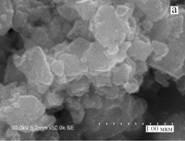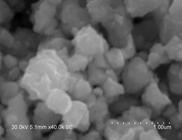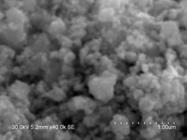Science / The most important results
2016
Synthesis of the single crystals of monoclinic hafnium dioxide.
Authors: N.I. Baklanova, V.V. Lozanov
High-purity (up to 99.99%) transparent lamellar single crystals of the monoclinic phase of hafnium dioxide up to 2 cm in size were synthesized for the first time. The developed method allowed us to grow single crystals at a temperature of 1000°C, which is about three times lower than the melting point. The single crystals possess photoluminescence in the visible region (red and blue light) when excited by the ultraviolet light, which may find application in the development of the sources of white light. A promising direction is to use the single crystal plates of hafnium dioxide in the newest biosensors to immobilize nucleic acids.

|
Publications:
V. V. Lozanov, N. I. Baklanova, V. R. Shayapov, A. S. Berezin. Crystal growth and photoluminescence properties of reactive CVD derived monoclinic hafnium dioxide. Cryst. Growth Des. 2016. Vol. 16. P. 5283?5293
New oxygen-permeable microtubular membranes.
Author: A.P. Nemudry
New oxygen-permeable microtubular membranes developed on the basis of nonstoichiometric perovskites provide record oxygen fluxes exceeding those reported in the literature by a factor of 2. The new material is characterized by 8 times higher energy efficiency in comparison with the best analogs. The manufactured membranes are applicable in oxygen separation from the air and may be needed in gas chemical industry to obtain valuable products form natural gas; they may also be useful in solving the ecological problems connected with the emission of greenhouse gases.

|

|
|
SEM image of a microtubular membrane based on
Ba0.5Sr0.5Co0.75Fe0.2Mo0.05O3-δ |
Temperature dependence of hte oxygen fluxes through the membrane
Ba0.5Sr0.5Co0.75Fe0.2Mo0.05O3-δ in comparison with the literature data |
Publications:
RF Patent for invention No. 2592627 "Gas chemical membrane reactor ", 2016. Authors: А.P. Nemudry, S.F. Bychkov, М.P. Popov, N.Z. Lyakhov.
Mechanochemical synthesis of highly dispersed refractory metal carbides.
Authors: T.F. Grigorieva, B.P. Tolochko, А.I. Ancharov, N.Z. Lyakhov
Ultrafine mechanocomposites Ti/C, Ta/C, Hf/C and carbides TiC, TaC, HfC with particle size 50-100 nm were successfully obtained through intense mechanochemical activation in a high-energy activator of the planetary type. Due to the unique properties – high melting point (up to 3900°C), micro-hardness (up to 3200 kg/mm2), electroconductivity and thermal conductivity, superfine carbides may find broad application for the development of solid alloys, high-temperature cathodes, materials for protection from radiation, for streamlined nosing of hypersonic aircrafts.

|

|

|
|
a)
|
b)
|
c)
|
|
SEM images of ultrafine carbides of titanium (a), tantalum (b) and hafnium (c) obtained through mechanical activation for 4 - 8 min.
|
||
Publications:
T.F. Grigorieva, B.P. Tolochko, А.I. Ancharov, S.V. Vosmerikov, Е.T. Devyatkina, Т.А. Udalova, E.А. Pastukhov, N.Z. Lyakhov. Mechanochemically stimulated reactions for the production of titanium carbide. Melts. 2016. No. 6. P. 465-475 (in Russian).





